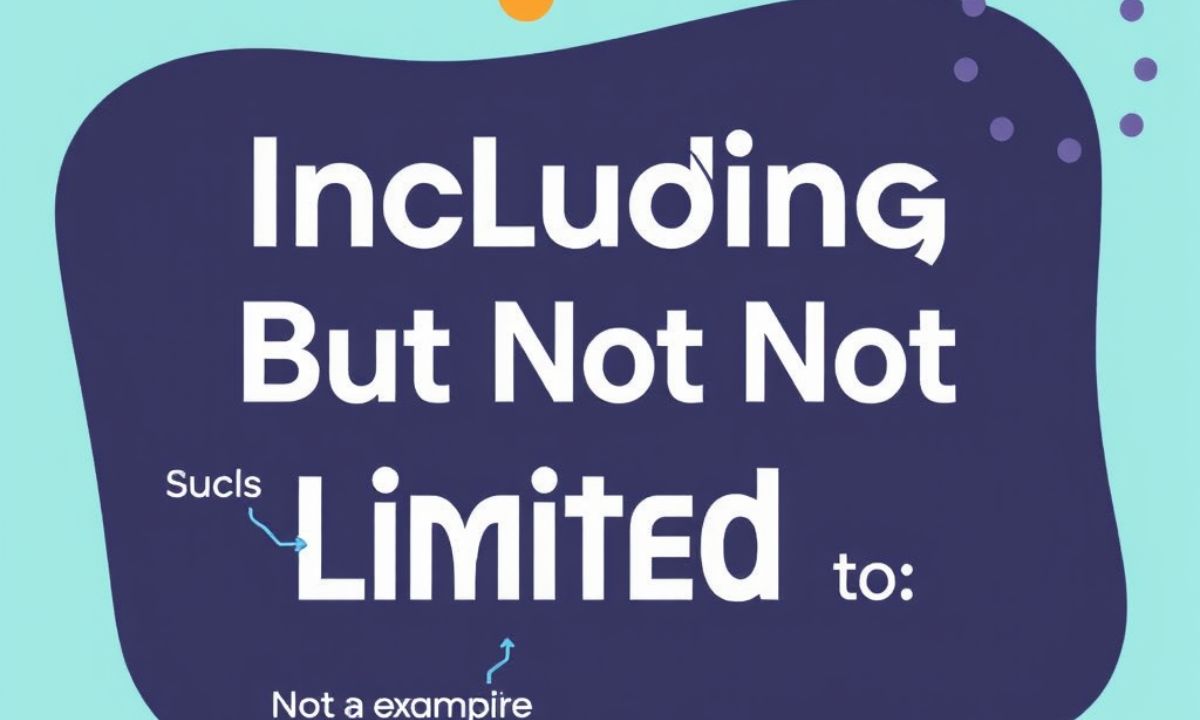The expression ‘including but not limited to’ is a useful phrase for the presentation of non-exhaustive lists, but different alternatives could serve to elucidate, modify the tone, or avoid unnecessary repetition in writing.
Here are ten professional alternatives listed along an axis from formal to casual, meaning that depending upon your choice, you could present a precise and inclusive message while somehow changing style.
A Non-Exhaustive List Includes
Using textual formal alternatives, it can raise the formal communication to a very high level by indicating thoroughness but the limitation to enumeration.
The Phrase is of religious care in documents that matter determination as in business documents, legal communication, or academia and goes beyond ensuring that everything was covered in the discussion.
The phrase carries an authoritative tone applicable to an executive, client, or formal stakeholder, hence advocating professionalism through carefully chosen words.
Its literalization works best, especially in reports, proposals, and official communications where clarity and broadness matter very much.
The formality of this expression adds credibility to the message but does not restrict the communication.
Example: A non-exhaustive list includes quarterly financial reviews, compliance audits, risk assessments, and strategic planning sessions.
Some Options Are
A casual alternative creates an approachable tone, an environment perfect for team communications, informal emails, and drafting together.
Relaxed wording invites engagement and discussion instead of a prescriptive list, making it ideal for brainstorming or when asking for input from team members.
Such straightforward expression makes complicated information accessible and breaks down communication barriers existing across departments or levels of a hierarchy within a company.
The conversational tone used for such phrases helps build rapport and create a more inclusive environment where team members feel comfortable bringing up other ideas beyond what has been articulated.
Its simplicity keeps formality in check and helps the speaker imply that other options may exist, not just the highlighted ones.
Example: Some options are working from home, flexibility in hours, or a hybrid schedule.
Such As, But Not Limited To
This balanced alternative keeps the formal tone intact, yet it categorically points out that the examples cited are not exhaustive.
Ideal for contracts, policy documents, and communications that have regulatory undertones, this leaves no doubt about the openness of categories so defined.
This combination of “such as” with the qualifications “but not limited to” creates comprehensive clarity that prevents misinterpretation in high-stakes communications.
Thus, in precision-inclined professional settings, it speaks of detail without misrepresenting the communication it seeks to guard against by excluding legitimate but unmentioned items.
This type of construction is really appreciated by legal and compliance professionals for keeping the case open with very applicable examples illustrating a point.
Example: Acceptable forms of identification include, such as, but not limited to, driver’s licenses, passports, and government-issued ID cards.
Including, But Not Limited To
This note is a straightforward substitution that eloquently and neatly balances approachability and professionalism.
This will fit within myriad business contexts. It will maintain the same traditional phrasing, yet modify the surrounding language through tonality alterations such that different audiences get the message while clarity remains in terms of exhaustiveness of examples.
Its familiarity makes it understandable right off, even for different audiences; thus, potentially confusing more uncommon phrasing is eliminated.
This phrase works perfectly well from both written and spoken forms in consistency through both communication channels in business.
This straightened phrase means you can convey even the more complicated messages by citing examples without putting strict limitations on such messages.
Example: Project deliverables include, including, but not limited to, wireframes, functional prototypes, and user testing reports.
Like, But Not Limited To
However, this converse marvel simply needs to be donned more personally and closely to really give it that vibe that examples are not limited in detail.
This phrase makes good fit with the entire web team meeting, informal emails, work by inputs, and so on. It breaks down walls of conventional and different types of language with the use of familiar patterns. “Like,” as a word, really shows how simple it is to relate examples.
This phrase usually fits well with contemporary cultures in communication that it makes more complex things easy to understand for various publics.
This phrasing would work well with any team member, client, or other stakeholder who arguably prefers to hear less formal modes of communication.
It does not promise absolute casualness, yet the “but not limited to” qualifier marks it as an expression for free into a kind of informal setting.
Example: The new version of the software has several new features such as, but not limited to, dark mode, voice commands, and improved security protocols.
Comprising, But Not Limited To
This formal alternative is suited for documents requiring authority such as official documents, legal communications, and high-class business correspondences.
The word comprising stands for a comprehensive relationship between the whole and the parts, going beyond mere inclusion, subtly enhancing the complexity of your technical vocabulary.
The term adds sophistication to speak the language of authority in situations where formal language is preferred or rewarded.
The structure implies extreme attention to detail while allowing a broad definition of any presented classifications.
Therefore, these terms are ideally used in academic writing, scientific documentation, and related professional fields, where precision in language conveys standards and expectations of the profession.
Example: The strategic plan addresses key performance areas that comprise market expansion, operational efficiency, and talent development.
Inclusive Of, But Not Limited To
This formal alternative stresses the degree of inclusiveness these examples will have in all the necessary flexibility-a notable trait in business communications.
The term “inclusive of” is an active way of stating comprehensiveness as opposed to simply introducing examples, which is most useful when underlining a thorough consideration of multiple things.
This goes a long way in communications related to diversity and inclusion, policy documents, and particularly in instances where showing thoroughness bears weight.
The other end of the spectrum combines formality with professionalism and consideration, a mix that allows it to shine equally brightly in settings ranging from human resources documents through corporate proposals.
Here the emphasis on inclusivity builds on the phrase’s internal meaning, which serves the practical function of illustrating non-exhaustive examples.
Exampe: The wellness program benefits are inclusive of, but not limited to, gym memberships, mental health resources, and nutritional counseling.
With Examples Such As
With examples like, another handy alternate creates a gentle conversation while demarcating a clear path for illustrating- but never restrictively.
The gentle begins with: “with examples such as” and does not appear too pedantic or formal for an academic context; training material; or explanatory correspondence.
This phrase makes it clear for the reader to understand that examples are given, for the most part, at the point of use.
This maintains a natural flow for the audience, encouraging active engagement and steering clear of communication fatigue that creeps in with the necessary level of formality.
This expression is particularly well suited for situations such as presentations, teaching guides, and any instances where citation of concrete examples is prioritized for the sake of building understanding.
Example: Effective team leadership skills, with examples such as active listening, constructive feedback, and conflict resolution, contribute to organizational success.
Comprised Of, But Not Limited To
These give a formal touch and accuracy to the tone required in expressions concerning professional communication ropes into those chosen with equal deftness; use of this phrase “comprised of” reveals that these examples parts of a more extended compendium, adding subtle complexity to your professional vocabulary.
In legal, academic, or even business-high professional contexts, such an expression is valuable and adds linguistic dexterity to credential and authority.
A solemn phrasing evokes careful attention paid to the word’s choice, which specifically and reflects considering one’s self in representation practically.
This phrasing works effectively in contexts in which precise phrasing of content contributes to positioning the professional in a specific domain.
Example: The investment portfolio is comprised of, but not limited to, blue-chip stocks, government bonds, and real estate holdings.
Containing, But Not Limited To
It is an alternative approach halfway between formal and conversational, ensuring that it remains clear with regard to non-exhaustive examples.
The word “containing” feels more natural in day-to-day business communication while still fulfilling the requirement of introducing examples without limiting the scope.
It fares well in many environments, from team emails to client presentations, catering to different audience needs. The simplicity of the construction provides immediate understanding while avoiding the extra stiffness that other formal options might convey.
This wording proves most handy when addressing different audiences with inconsistent preferences toward formality.
Example: The employee benefit package containing, but not limited to, health insurance, retirement plans, and professional development allowances, attracts top talent.
FAQ’s
When should I use formal alternatives like “a non-exhaustive list includes” instead of casual options?
Use formal alternatives in official documents, legal communications, and when addressing superiors or clients in professional settings.
Can these alternatives be used interchangeably in all professional contexts?
While serving similar functions, each alternative carries subtle tonal differences that should match your audience, purpose, and communication medium.
How do these alternatives impact the legal interpretation of documents?
Like “such as, but not limited to” help prevent restrictive interpretations while still providing necessary examples for clarity.
Why is it important to vary how I introduce non-exhaustive lists in professional writing?
Variation prevents repetitive language, demonstrates linguistic versatility, and helps maintain reader engagement throughout longer communications.
READ MORE: https://travelloverage.com/ways-to-say-thank-you-for-reaching-out-to-me/
Conclusion
Choosing the right alternative that goes along with “including but not limited to” will certainly serve to strengthen articulation across different lines of professions.
These suggest alternatives suited to the varying degrees of tone or formalities while the examples offered are never meant to be exhaustive.
An appropriate choice shows linguistic versatility and audience awareness, two key competencies in professional communication.
By choosing the right option, there is an opportunity to affect the subtle reception different options have, with the consequence of active engagement, clarity, and professionalism.
Mastering these options enhances communication skill in general, as it abstains from repetition while keeping accuracy. In their own professional jargon, it helps to choose the expressions they incorporate based on the context, audience, and intention.
Attention to such detail illustrates the degree of care and concern that distinguishes truly effective professional communication from messaging that is really a lot more lackluster.

I’m Irfan, an experienced SEO content and SEO specialist with 2 years of expertise, currently contributing to Al Jazeera News Website.












